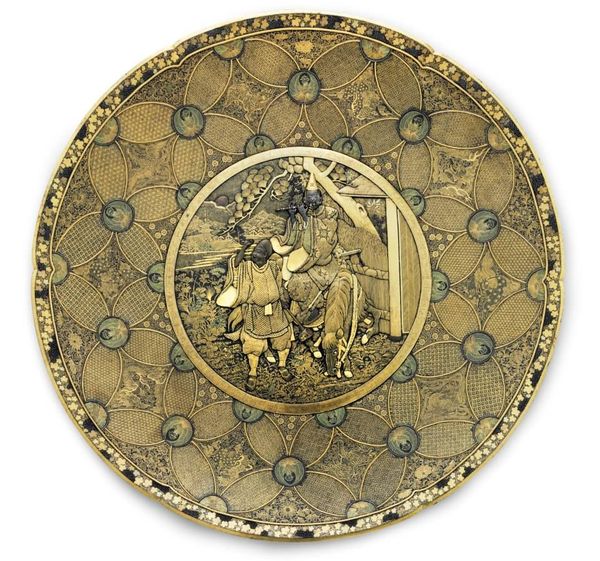A large inlaid-iron dish, Meiji period (late 19th century), signed Nihon koku Kyoto ju Komai sei
A large inlaid-iron dish, Meiji period (late 19th century), signed Nihon koku Kyoto ju Komai sei. Photo Christie's Image Ltd 2013
The shallow dish with lobed rim, inlaid in gilt, silver and shakudo nunomezogan, hirazogan and takazoganwith a large central roundel of Minamoto no Nakakuni riding a horse and playing a flute, encircled by continuous shippo patterns designed with pairs of dragons, kirin, tigers, phoenixes and lions on a geometric and floret ground, the rim with a border of scrolling grape vines, signature on base; 15¾in. (40cm.) diameter. Estimate $70,000 – $90,000
Notes: A courtier on horseback stops to play his flute at a rustic gate on an autumn evening. The full moon rises above distant hills, illuminating the pagoda of a temple. The setting is the rural Saga district in the southwestern suburbs of Kyoto, the ancient capital. The horse grazes among autumn grasses, including miscanthus and ominaeshi. This subject, a romantic episode drawn from the Tale of the Heike, was immortalized in the Noh play Kogo, and then popularized in the Meiji period by the print artist Tsukioka Yoshitoshi in his 1891 series One Hundred Aspects of the Moon.
According to the story, the twelfth-century Emperor Takakura loved Lady Kogo, the daughter of a Fujiwara nobleman. However, the powerful warrior Taira no Kiyomori wanted to pair the emperor with his own daughter, Chugu. To this end, Kiyomori banished Kogo from the capital, and she went into hiding in Sagano. The emperor longs for Kogo and orders Minamoto no Nakakuni to search for his beloved, who was known for exceptional skill playing the koto. The emperor has heard only that she lives in a humble abode with a single-door gate. As it is the fifteenth of the eighth month--the night of the full moon--Kogo is sure to be playing her koto. Nakakuni cleverly hits on the idea of playing his flute so as to elicit a response from Kogo. Here, we see him at the gate of her refuge, and we are left to imagine the sound of her koto, and Nakakuni's own mixed emotions.
Christie's. JAPANESE AND KOREAN ART. 18 September 2013. New York, Rockefeller Plaza.

/https%3A%2F%2Fprofilepics.canalblog.com%2Fprofilepics%2F1%2F0%2F100183.jpg)
/https%3A%2F%2Fstorage.canalblog.com%2F03%2F02%2F119589%2F96711876_o.jpg)
/https%3A%2F%2Fstorage.canalblog.com%2F11%2F31%2F119589%2F94773502_o.jpg)
/https%3A%2F%2Fstorage.canalblog.com%2F20%2F83%2F119589%2F94772815_o.jpg)
/https%3A%2F%2Fstorage.canalblog.com%2F26%2F72%2F119589%2F75604929_o.jpg)
/https%3A%2F%2Fstorage.canalblog.com%2F59%2F60%2F119589%2F26458628_o.jpg)



/http%3A%2F%2Fstorage.canalblog.com%2F33%2F19%2F119589%2F126939513_o.jpg)
/http%3A%2F%2Fstorage.canalblog.com%2F64%2F60%2F119589%2F126895227_o.jpg)
/http%3A%2F%2Fstorage.canalblog.com%2F18%2F17%2F119589%2F126742644_o.jpg)
/http%3A%2F%2Fstorage.canalblog.com%2F90%2F16%2F119589%2F126573693_o.jpg)